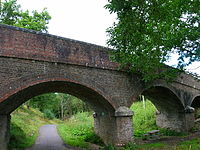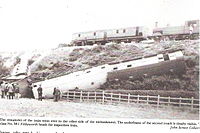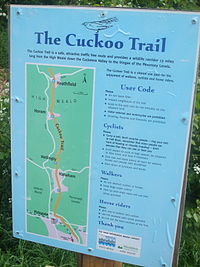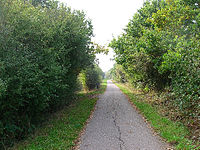- Cuckoo Line
-
Coordinates: 50°49′52″N 0°15′11″E / 50.831°N 0.253°E
'The Cuckoo Line'
(Tunbridge Wells West to Polegate)Legend




Hastings Line (towards Tonbridge) 









Wells Tunnel 




Tunbridge Wells ('Central') 




Grove Hill Tunnel 




Grove Junction 




Grove Tunnel 




Tunbridge Wells West (Spa Valley Railway) 




Hastings Line (towards Hastings) 




High Rocks Halt (SVR) 




Groombridge (SVR) 




Oxted Line towards London 




to Three Bridges via East Grinstead HL 




Birchden Junction 




Eridge 




Redgate Mill Junction 




Oxted Line towards Uckfield 




Wealden Line towards Lewes 




Rotherfield & Mark Cross (Closed 1965) 




Mayfield Tunnel 




Mayfield (Closed 1965) 




Heathfield Tunnel 265 yards (242 m)) 




Heathfield (Closed 1965) 




Horam (Closed 1965) 




Hellingly Hospital Railway (Closed 1958) 




Hellingly (Closed 1965) 




Proposed Ouse Valley Railway (not built) 




Hailsham (Closed 1968) 




Proposed Ouse Valley Railway (not built) 




East Coastway Line 




Polegate
The Cuckoo Line[1][2] is an informal name for the now defunct railway service which linked Polegate and Eridge[3] in East Sussex, England, from 1880 to 1968. It was nicknamed the Cuckoo Line by drivers, from a tradition observed at the annual fair at Heathfield, a station on the route. At the fair, which was held each April, a lady would release a cuckoo from a basket, it being supposedly the 'first cuckoo of spring'.[4]Contents
The railway line served the following Sussex communities: Polegate, Hailsham, Hellingly, Horam for Waldron, Heathfield, Mayfield, Rotherfield and Eridge. Services continued through Eridge and onward via Groombridge to Tunbridge Wells.
The Hailsham-Eridge section closed in 1965, the Polegate-Hailsham branch surviving until 1968. Eridge-Tunbridge Wells closed in 1985, and this line has been resurrected as the Spa Valley Railway.
History
The Cuckoo Line was built by the London Brighton and South Coast Railway (LBSC&R) in two sections, starting with the branch from Polegate to Hailsham which opened to traffic on 14 May 1849. The remainder of the line to Eridge opened to traffic in September 1880.[5]
The line from Three Bridges to Tunbridge Wells (via East Grinstead High Level and Groombridge) opened on 1 October 1866, with the connecting line from Uckfield via Eridge opening on 3 August 1868. The final part of the route opened on 1 February 1876: a connection between the LBSCR station at Tunbridge Wells West and Tunbridge Wells Central, the station operated by the South Eastern Railway (SER). This single-line section passed through the short Grove Tunnel to Grove Junction, sited a little south of the SER station on their Hastings Line.[6] In 1881 a new track alignment was built between Polegate and Hailsham allowing trains to run into Polegate at the west end of the station and direct to Eastbourne.
At the 'Grouping' in 1923, the railway passed into the control of the Southern Railway. When the Southern Railway was nationalised in 1948, the line became part of the Southern Region of British Railways.
Following the Beeching Report in 1963, the line was recommended for closure. The section from Eridge to Hailsham was closed to passenger traffic in 1965 (the section between Heathfield and Hailsham remaining open for freight until 1968), whilst the short branch from Polegate to Hailsham remained open until 8 September 1968. The closure of this section was hotly disputed[5] – even British Railways themselves agreeing that Hailsham was a growing town and that buses would be unable to cope with the demands of the increasing population.
The line between Eridge and Tunbridge Wells West remained open until 1985. Despite having survived 'Beeching', no money was spent on the line and British Rail regarded a track and signalling upgrade to be unviable. Closure was announced in February 1985, and the last passenger trains ran on 6 July 1985. Grove Junction was removed the day after closure, but the depot at Tunbridge Wells West remained in use for another month.[6]
The Cuckoo Line today
See also: Spa Valley RailwayToday, the Cuckoo Line remains a closed railway – a footpath and cycleway known as The Cuckoo Trail runs along much of the route from Polegate to Heathfield. Polegate retains a railway station, albeit on a different site to the one formerly used by Cuckoo Line trains, whilst the site of the station in Hailsham is now occupied by housing estate. At Horam the platforms are preserved including a nameboard. Hellingly station survives as a private residence, Heathfield station building is now a shop selling kitchen utensils but the site of the platforms are now occupied by industrial units. At Mayfield the station building survives as a private residence but the trackbed has now been removed and replaced by the A267 Mayfield bypass. Rotherfield and Mark Cross station is a private residence. Soon after closure of the Tunbridge Wells West to Eridge section, a preservation society was formed with the intention of reinstating the passenger service on the line. The Tunbridge Wells and Eridge Railway Preservation Society (TWERPS) acquired the line in March 1996 and by December 1996 had started to run a steam-hauled passenger service along part of the route. The line has been marketed as the Spa Valley Railway and they have gradually extended services with the final section to Eridge opening on the 25th of March 2011.
 Shawpits Bridge, near Hellingly
Shawpits Bridge, near Hellingly
Campaign
A campaign group has been started to lobby for the line to be re-opened - operated as part tourist operation and part commuter service. [1]
Although the group wish to see the line from the outskirts of Heathfield (largest town in the south without a rail station) to Eridge reopened, this would be a costly project. In places, new alignment would be required. This would involve the purchase of land, and would lead to a circuitous route.
Accidents
 D1 Class No. 297 Bonchurch and train, derailed at Tooth's Bank, North of Heathfield, September 1897.
D1 Class No. 297 Bonchurch and train, derailed at Tooth's Bank, North of Heathfield, September 1897.
The line had a good safety record: there was only one reported accident on the line. On 1 September 1897 at Tooth's Bank, 2 miles north of Heathfield, the 08:18am service from Eastbourne was running around 4 minutes late and was trying to pick up time in order to meet a connecting train at Groombridge. As the train entered the corner at around 40mph it left the tracks. Driver James McKinlay was killed and Fireman Lewis Minns seriously injured, whilst 30 passengers suffered minor injuries. [5]
In April 1968 a lorry collided with a low road bridge under the line at Horsebridge north of Hailsham damaging the bridge causing immediate closure of the line. As the freight train service between Hailsham and Heathfield was due to be withdrawn the following month it was not considered worthwhile repairing the bridge so the line was prematurely abandoned forthwith. Some wagons isolated at Heathfield goods yard were cut up on site.[citation needed]
Stations served
Route description
The Cuckoo Line diverged from the main Eastbourne to London line at Polegate, and ran northwards on a single track to the market town of Hailsham, which was the terminus for 31 years until the line through to Eridge had been completed. The line then passed through the villages of Hellingly (where a link to the Hellingly Hospital Railway joined the route, worked by overhead electric traction), Horam, Heathfield, Mayfield, Rotherfield & Mark Cross, then via Redgate Mill Junction to join the Oxted Line for Eridge. The route continued north-eastwards, leaving the Oxted Line at Birchden Junction heading for Groombridge, High Rocks Halt and eventually Tunbridge Wells West. Through trains could continue on the single-track connection through Grove Tunnel to join the Hastings Line (heading towards Tunbridge Wells Central) at Grove Junction.
Name changes
Horam station was originally built as Horeham Road. In 1900 it was renamed Waldron & Horeham Road.[7] Over the years, Horeham changed to Horam as the hamlet grew around the station, prompted by growth including an Express Dairies depot, and the name changed again in 1935, before becoming simply Horam in September 1953.
See also
- List of closed railway stations in Britain
- Spa Valley Railway
- Cuckoo Trail
- Heathfield to East Grinstead Campaign
References
- ^ S. K. Baker (1980). Rail Atlas of Britain (3rd Edition). Oxford Publishing Company. pp. 12. ISBN 0-86093-106-4.
- ^ W. Philip Conolly (1958/1976). British Railways Pre-Grouping Atlas and Gazetteer. Ian Allan Ltd. pp. 5. ISBN 0-7110-0320-3.
- ^ 50°50′13″N 0°27′36″E / 50.837°N 0.460°E
- ^ "The Cuckoo Line". Villagenet. 2000. http://www.villagenet.co.uk/history/1880-cuckooline.html. Retrieved 2007-06-23.
- ^ a b c A. C. Elliott. The Cuckoo Line. Wild Swan Publications Ltd. pp. 33, 139. ISBN 0-906867-63-0.
- ^ a b Catford, Nick. "Tubridge Wells West Station". Subterranea Britannica. http://www.subbrit.org.uk/sb-sites/stations/t/tunbridge_wells_west/index.shtml. Retrieved 2007-07-05.
- ^ Catford, Nick. "Horam Station". Subterranea Britannica. http://www.subbrit.org.uk/sb-sites/stations/h/horam/index.shtml. Retrieved 2007-06-24.
Categories:- Rail transport in East Sussex
- Beeching closures in England
- Railway lines opened in 1880
- Closed railway lines in South East England
- Railway lines closed in 1968
- Standard gauge railways in England
Wikimedia Foundation. 2010.


